Clothes for Swimming Lessons
Sportswear is best for advanced swimming lessons because it is robust and designed to get wet.
For fun lessons in the pool you want quick drying clothes that feel good both wet or dry. This means you can get in and out of the water quickly and follow the lesson without distraction.
A good choice are three unlined clothing layers. Start swimming in the base layer, then add middle and outer layer over time. For realistic training wear all the clothes you would wear for your watersports, even socks and shoes where applicable. The shoes should be made of canvas fabric.
Some clothing can be hard to put on or take off when it is wet.
This can get you frustrated during the lesson.
We recommend buying comfortable clothes which are meant to get wet and fit well in the water.
Try them on in your bathtub or shower first.
Below you find a detailed list of kit for each stage of the swimming course.
Beginner: T-shirt and Shorts
Tee-shirt and shorts the best swimwear for beginners, easy to swim in. This is the basic swimwear you will need for all lessons. More will be worn on top later in the course.
You can wear your usual home T-shirt and shorts in the pool. Nylon shorts and a swim shirt are easy to swim in and look great. They come in many colours and styles to make up stylish outfits.
Sportswear is best as it can cope with frequent immersions and is robust enough. Made from nylon or polyester it doesn't soak up much water and dries quickly. Any sports or footy kit will do as long as it is comfy and doesn't chafe. No need to buy special swimwear.
Put aside a few shirts and shorts as part of your swimming kit.
Always keep them in your swim bag when dry.
Wet kit should be hung up to dry as soon as possible, otherwise it starts to rot and smell.
Intermediate: Long-Sleeve Top and Long Pants
Sportswear or tracksuits are often thicker and take more swimming effort. This additional clothing layer is deliberately used to slow down the students and make swimming harder. It is worn on top of the shirt and shorts from the beginner lessons.
Long trousers, jeans or tracksuit bottoms are combined with a sweatshirt or hoodie for more the demanding lessons. Cotton soaks up much more more water and gets heavy, but it takes longer to dry out.
For resistance swim training, students will learn to conserve their energy by optimizing their swim strokes, and continue swimming for longer to meet their goal.
While you swim in swim briefs or such, you can get away with very bad swimming strokes. Almost anything works to some degree. Just look at a busy pool to notice this.
When you swim fully clothed you may not move much at all at first.
This is where you can now tweak your swimming strokes.
Rapid progress can be made in reasonable time.
Advanced: Waterproof Clothes
Unlined anoraks and rain pants are best for water safety training and splash sports. Waterproof clothes are worn on top of the beginner or intermediate outfits for survival swim training or adventure swimming preparation.
These clothes cause some considerable drag when swimming and are thus useful for strength and endurance training. They are also ideal for any fun splash sports in the pool, like canoe and kayak lessons, or wild water games with frequent immersion.
Although they don't soak up much water, they hold pockets of air and water that swimmers should learn how to handle. Special techniques can quickly vent any air and drain water away.
Finally, students will learn how to make a buoyancy aid using their pants.
It is important to get the right pants for it to easily inflate like a balloon.
Some pants just do not inflate as the air escapes from the tiny pores in the fabric.
Waterproof pants work best.
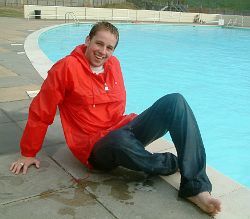
Long pants and anorak are good pool training clothes and easy to swim in. The nylon fabric doesn't clog up the pool filters with fluff.
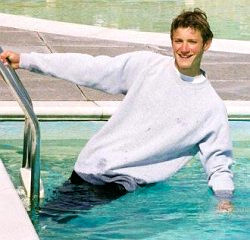
A fleece pullover soaks up water and gets heavy when wet. Good for strength training.
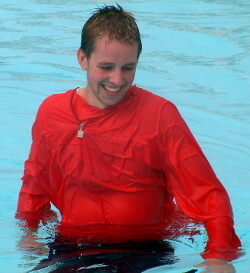
An anorak is lightweight but causes a fair bit of drag.
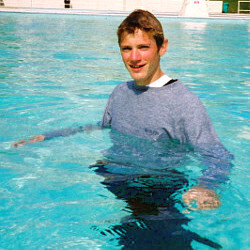
Get used to the way clothes feel in the water. They slow you down, but don't pull you down.
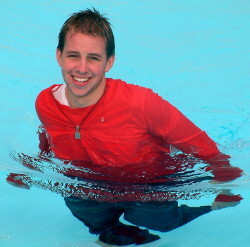
Shallow water wading shows the drag resistance of your clothes. This awareness is important for safe water sports.
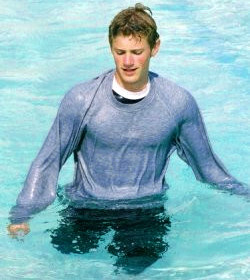
Wading helps to build up leg muscles and lower body strength.
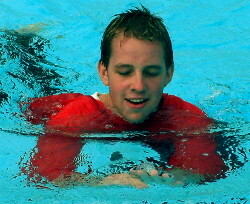
Swimming a few lengths lets you see how well your clothes fit. They should feel good in the water.
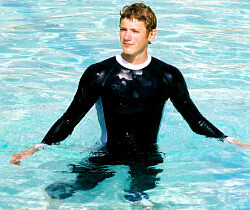
A comfy swimsuit makes a good base layer so you can change into different clothes on poolside.
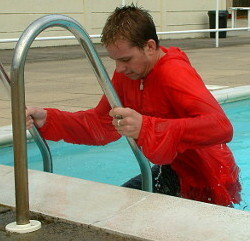
As you climb out you'll notice how much waterlogged clothes weigh.
Keep Warm
Your clothing protects you from wind, sunburn, cuts and bruises. Which clothes you'll need depends on the weather and what sport you're training for, unless you swim in clothes just for fun.
Dress for immersion, not the air temperature. Clothes are meant to keep you warm. This also holds true in the water, up to a point. T-shirt, jeans and hoodie might be fun for resistance swim training, but cotton can seriously chill you out over time when you come out of the water. It holds on to a lot of water which cools you as it evaporates.
Functional fibres like fleece keep you warm even when wet because they can form a warmth pad on the body.
They reduce the water flow over your skin which keeps you warmer.
You're more comfortable in the water when you dress warm enough in comfy clothes.
Are Clothes Heavy in Water?
Not really. Contrary to popular belief, clothing weighs very little in water, is no heavier than dry clothing on land. The weight on you is even reduced by the buoyancy as long as you stay underwater. Only when you come out of the water does the full weight of the wet clothes weigh on you.
Throw an item of clothing into a swimming pool and notice how slowly it sinks, if at all. Pull it out of the pool and it gets heavy with all the water it soaked up. Cotton and fleece soaks up more than unlined nylon rainwear.
Big boots are completely unsuitable, they run full, their weight actually pulls your feet down slightly.
You have to use significantly more force to hold your position.
Don't Confuse Slow Down with Weigh Down
Many people who haven't tried swimming fully clothed, wrongly think they get pulled down by the weight of wet clothes. You will not be pulled down by your clothing. You can swim on the surface of the water with clothes just as you would in normal swimwear, maybe a bit slower and with more effort.
When you wear clothes in the water, they just float around you. The soaked up water only displaces water which would have been there anyway. Water weighs nothing in water, so they only weigh you down by their DRY weight, minus the weight of water displaced by the fabric. The water which is soaked up by the fabric, or collects inside your clothes, will slow down your movements.
However, the swimming movements are more difficult because you have to overcome greater water resistance.
The wider the clothes are cut, the more they float around under water,
and the resistance increases accordingly.
This makes it harder on your muscles to move you forward and thus improves training results.
As a result, you move more slowly and require more strength and stamina.
This build muscles.
Think of it as your aquatic gym.
Summary
Now that you're properly dressed for your swimming experience, choose a safe and shallow area to begin with, maybe chest deep. This can be a beach, lake, or swimming pool. As you gain strength and fitness, increase your training level. Begin with a single layer of light clothing. Add more layers until you're fully clothed. When you can move in the water with confidence you're ready for the great outdoors.
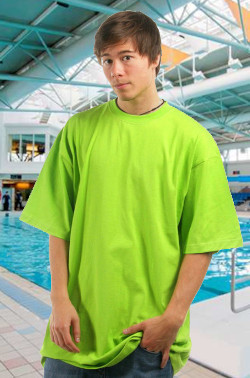
Beginner
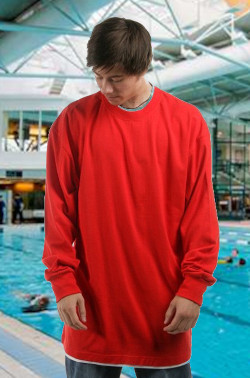
Intermediate
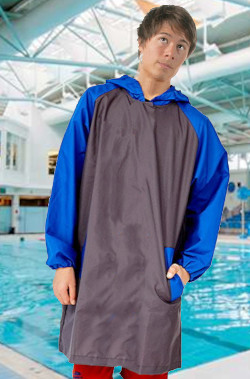
Advanced